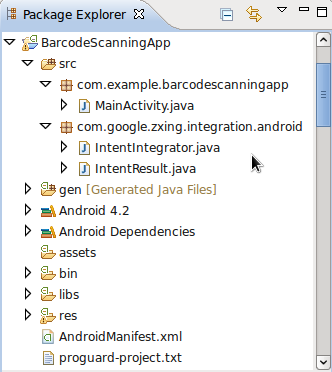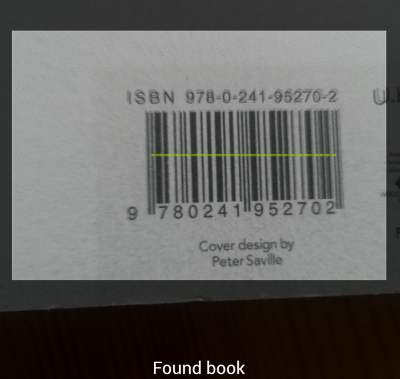Since we're using the ZXing library, we don't need to worry about users without the barcode scanner installed, because the integration classes provided will take care of this for us. By importing the ZXing integration classes into our app, we can make user scans easier and focus our development efforts on handling the scan results. In a follow-up series coming soon, we'll develop a book scanning app where we'll build on the app we created in this tutorial. We'll also add support for Google Books API so that we can display information about scanned books.
1. Create a New Android Project
Step 1
In Eclipse, create a new Android project. Enter your chosen application, project, and package names. Let Eclipse create a blank activity for you, with the name of your choice for both the activity and its layout.
Step 2
Open your main layout file. With the default settings, Eclipse starts your layout with a Relative Layout object, which you can leave as is. Inside of it, replace the existing content (typically a Text View) with a button.
01
02
03
04
05
06
07
08
09
10
| android:layout_width="match_parent" android:layout_height="match_parent" > <Button android:id="@+id/scan_button" android:layout_width="wrap_content" android:layout_height="wrap_content" android:layout_centerHorizontal="true" android:text="@string/scan" /></RelativeLayout> |
01
02
03
04
05
06
07
08
09
10
11
12
13
14
| <TextView android:id="@+id/scan_format" android:layout_width="wrap_content" android:layout_height="wrap_content" android:textIsSelectable="true" android:layout_centerHorizontal="true" android:layout_below="@id/scan_button" /><TextView android:id="@+id/scan_content" android:layout_width="wrap_content" android:layout_height="wrap_content" android:textIsSelectable="true" android:layout_centerHorizontal="true" android:layout_below="@id/scan_format" /> |
1
| <string name="scan">Scan</string> |
2. Add ZXing to Your Project
Step 1
ZXing is an open source library that provides access to tested and functional barcode scanning on Android. Many users will already have the app installed on their devices, so you can simply launch the scanning Intents and retrieve the results. In this tutorial we are going to use the Scanning via Intent method to make scanning easier. This method involves importing a couple of classes into your app and lets ZXing take care of instances where the user does not have the scanner installed. If the user doesn't have the barcode scanner installed, they'll be prompted to download it.
Tip: Since ZXing is open source, you can import the source code into your projects in its entirety. However, this is really only advisable if you need to make changes to its functionality. You can also compile the project and include its JAR file in your own apps if you prefer. For most purposes, using Scanning via Intent is a reliable and easy to implement options, plus your users will have access to the most recent version of the ZXing app.
In Eclipse, add a new package to your project by right-clicking the "src" folder and choosing "New", then "Package", and entering "com.google.zxing.integration.android" as the package name.
Step 2
Eclipse offers several ways to import existing code into your projects. For the purposes of this tutorial, you'll probably find it easiest to simply create the two required classes and copy the code from ZXing. Right-click your new package, choose "New" then "Class" and enter "IntentIntegrator" as the class name. You can leave the other default settings the way they are. Once you've created this class, do the same for the other class we'll be importing, giving it "IntentResult" as its class name.
Copy the code from both classes in the ZXing library and paste it into the class files you created. These are IntentIntegrator and IntentResult. Refer to the source code download if you're in any doubt about where the various files and folders should be or what should be in them.

You can now import the ZXing classes into your main Activity class.
1
2
| import com.google.zxing.integration.android.IntentIntegrator;import com.google.zxing.integration.android.IntentResult; |
1
2
3
4
5
6
7
8
| import android.os.Bundle;import android.app.Activity;import android.content.Intent;import android.view.View;import android.view.View.OnClickListener;import android.widget.Button;import android.widget.TextView;import android.widget.Toast; |
3. Do Some Scanning
Step 1
Let's implement scanning when the user clicks the button we added. In your app's main activity class, the default onCreate method entered by Eclipse should look something like this.
1
2
3
4
| protected void onCreate(Bundle savedInstanceState) { super.onCreate(savedInstanceState); setContentView(R.layout.activity_main);} |
1
2
| private Button scanBtn;private TextView formatTxt, contentTxt; |
1
2
3
| scanBtn = (Button)findViewById(R.id.scan_button);formatTxt = (TextView)findViewById(R.id.scan_format);contentTxt = (TextView)findViewById(R.id.scan_content); |
1
| scanBtn.setOnClickListener(this); |
1
| public class MainActivity extends Activity implements OnClickListener |
Step 2
Now we can respond to button clicks by starting the scanning process. Add an onClick method to your activity class.
1
2
3
| public void onClick(View v){//respond to clicks} |
1
2
3
| if(v.getId()==R.id.scan_button){//scan} |
1
| IntentIntegrator scanIntegrator = new IntentIntegrator(this); |
1
| scanIntegrator.initiateScan(); |
Tip: When you call the initiateScan method, you can choose to pass a collection of the barcode types you want to scan. By default, the method will scan for all supported types. These include UPC-A, UPC-E, EAN-8, EAN-13, QR Code, RSS-14, RSS Expanded, Data Matrix, Aztec, PDF 417, Codabar, ITF, Codes 39, 93, and 128. The ZXing library also includes barcode scanning options that we're not going to cover in this tutorial. You can check the project out at Google Code for more info.
4. Retrieve Scanning Results
Step 1
When the user clicks the scan button, the barcode scanner will launch. When they scan a barcode, it will return the scanned data to the onActivityResult method of the calling activity. Add the method to your main activity class.
1
2
3
| public void onActivityResult(int requestCode, int resultCode, Intent intent) {//retrieve scan result} |
1
| IntentResult scanningResult = IntentIntegrator.parseActivityResult(requestCode, resultCode, intent); |
Step 2
As with any data being retrieved from another app, it's vital to check for null values. Only proceed if we have a valid result.
1
2
3
| if (scanningResult != null) {//we have a result} |
1
2
3
4
5
| else{ Toast toast = Toast.makeText(getApplicationContext(), "No scan data received!", Toast.LENGTH_SHORT); toast.show();} |
1
| String scanContent = scanningResult.getContents(); |
1
| String scanFormat = scanningResult.getFormatName(); |
Step 3
Now your program has the format and content of the scanned data, so you can do whatever you want with it. For the purpose of this tutorial, we'll just write the values to the Text Views in our layout.
1
2
| formatTxt.setText("FORMAT: " + scanFormat);contentTxt.setText("CONTENT: " + scanContent); |


Conclusion
In this tutorial, we've run through the process of facilitating barcode scanning within Android apps using the ZXing library. In your own apps, you might want to carry out further processing on the retrieved scan results, such as loading URLs or looking the data up in a third party data source. In the follow-up to this tutorial, we'll use the barcode scanning functionality to create a book scanning app that will allow us to retrieve data about scanned books from the Google Books API.Source : http://code.tutsplus.com/tutorials/android-sdk-create-a-barcode-reader--mobile-17162